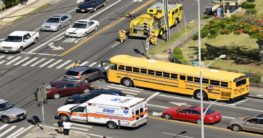
As a parent getting your child all buckled up before engaging the ignition of your car, is a well-accustomed lifestyle, but have you ever wondered how buckled they get inside those yellow long school buses? With the occasional reports of school bus crashes, parents, pediatric associations, and National Highway Traffic Safety Administration (NHTSA) have raised concerns over the safety of school buses.
It is true that hospitals across the world have always witnessed the treatment of injuries on children arising from school bus crashes, but should that dismiss the safety promised in school buses? A little delving into the benefits as well as the unavoidable pitfalls of this school long tradition may give answers to the question “are school buses safe?”
The benefits…
- You are spared the rush of competing with traffic especially if you are a worker and you have an early morning meeting in the office. You have all your conveniences assured while being a great parent.
- Your children get to make friends snappily with their peers and this gets them excited making every school day.
- Contemporary school buses are designed within Electronic stability control, Collision mitigation systems, Video cameras on both the inside and outside of the bus, Lane departure warnings, and Student and vehicle tracking technology.
Drawbacks.
- The seat buckle may not be adhered to by the children if they are available.
- It looks a little crowded inside and kids that are given to bullying can have a field day.
- The crashes usually happen 10feet behind or beside the bus known as the “danger zone” these accidents may be caused by the school bus or a passing vehicle.
With all these, keeping up with the best safety measures is still the safest way for the transporting of the children to school. Some of the tips as recommended by The National Highway Traffic Safety Administration (NHTSA) include.
- Endeavoring to get your child to the bus stop 5 minutes before the bus arrives.
- Try to stay 6-feet away from the curb when you see the bus approaching.
- All children must line up before the bus door and not beside the bus.
- While awaiting the arrival of the bus, make sure the child is not playing around the pedestrian.
- You must wait for the driver to stop, open the bus, and orders everyone to line up.
- If you are crossing the road, double-check and confirm that you are seen by the bus driver before crossing. And always use the pedestrian/sidewalk.
- The child must hold the bus rails when climbing and when coming down to prevent a slip.
- If you mistakenly dropped anything, alert the driver before going down for it and lastly never walk or stand behind a bus or any vehicle, chances of the driver seeing you or your child is slim.
Since school buses are not a tradition that any school hopes to discard in the future, a little compliance to these easy tips will help it get safer for everyone.
School Bus Laws
In the State of Texas, the Department of Public Safety (DPS) would like to remind drivers that it is illegal to pass any school bus that is stopped and operating a visual signal. More than 40,000 school buses transport 1.5 million Texas children every school day. A driver who is traveling in either direction must stop when approaching a school bus that is stopped and operating a visual signal. The driver cannot continue until the school bus is in motion, the operator has been given a signal by the bus driver to proceed, or the visual signal is no longer on.
Drivers who violate the law could face fines as much as $1,250.
Here are several safety measures drivers can take to help keep children safer:
- When driving in school zones, watch out for student pedestrians.
- Slow down and watch for children congregating near bus stops.
- Look for children who might dart into the street without looking for traffic.
- Know and obey the laws concerning traffic and school buses in Texas.
- Obey the posted speed limit.
- Fines double in school zones.
Tips for Students
- Stand far back when you are waiting for the bus.
- Sit still so the driver can pay attention to the road.
- Look both ways if you have to cross the street after getting off the bus, or wait for the driver to signal it’s safe to cross the street.
Please remember to pay attention when driving and obey all traffic laws, especially when those laws are set in place to protect the students riding a bus. Do not rush through a school zone, or pass a bus up simply to get to the next light. Your negligence can cause serious injury to innocent children looking to get home. If you have been injured due to someone’s negligence, please call one of our experienced lawyers for a free consultation.
Sinkhole Causes School Bus to Get Stuck
A sinkhole in Flour Bluff caused one school bus to get stuck, damaging a water line in the process. The bus driver had driven around a cone that was placed on the road when the ground beneath collapsed. Luckily the bus driver was the only one on board. Police reported that the water department was called out to the scene where crews spent most of the morning trying to get the buses’ front tires out of the sinkhole. Thankfully, no one was injured.
According to Caller-Times, there had been a water leak earlier in the day which is why the area had already been barricaded. The city’s water department distribution superintendent, Michael Olivarez, stated that the residents surrounding the area were not affected by the water leak or the sinkhole.
A sinkhole is a cavity in the ground, or a depression, due to water erosion which causes the surface layer to collapse. According to a geological survey, sinkholes are very common in the world including the United States. Particularly in Texas, Alabama, Missouri, Kentucky, Tennessee, Pennsylvania, and Florida.
Whether natural or man-made, sinkholes are dangerous, especially when they occur in heavily populated areas. They can cause not only structural damage to buildings but can also damage human life. Toxic chemicals can rise up from beneath the earth and pollute groundwater. Most of the time they form slowly that you can’t notice a change, but if they form fast and without warning, the results can be major. Although sinkholes are very serious and can be devastating, deaths are very rarely associated with them.
There are different types of sinkholes:
- Dissolution sinkholes – This is where dissolution of the limestone is most intensive, where the water first contacts the rock surface. It’s most aggressive in pre-existing openings in the rock.
- Cover-subsidence sinkholes – These develop gradually where the covering sediments are permeable, allowing liquids or gases to pass through it, and contain sand.
- Cover-collapse sinkhole – These are catastrophic and form abruptly over a period of hours occurring where the covering sediments contain a significant amount of clay.
- Human-induced sinkhole – land-use practices have been correlated with the emergence of new sinkholes. Groundwater pumping, construction, and development practices are all causes of human-induced sinkholes. This includes when new water-diversion systems are developed, and runoff-storage ponds are created.
What is happening is that people are spreading across the globe and moving to new areas susceptible to them. With changing events in the weather due to climate change, such as flooding and hurricanes, it is very likely that we can see an increase in them over the next few years.
If you have been injured, please contact an attorney at Herrman and Herrman, P.L.L.C., to schedule a free consultation. Visit our office at 1201 Third St. or give us a call at 361-792-2358.
CONTACT HERRMAN & HERRMAN IF YOU HAVE BEEN INJURED IN ANY OF THE FOLLOWING TYPES OF ACCIDENTS:
We can help you if you have been harmed by the following:
- Car accidents – Our lawyers have extensive experience handling car accident cases. We will work to identify the party or parties at fault for the crash and build a case to demonstrate persuasively how the parties caused the accident and your injuries. We will seek fair and full compensation through a negotiated settlement or at trial if necessary.
- Truck accidents – Thousands of large commercial trucks travel the roads of Texas every single day. Unfortunately, careless truck drivers and trucking companies disregarding safety put innocent people at risk of serious injuries. If you’ve been injured in a truck accident, let our experienced Texas personal injury lawyers stand up to the trucking companies and insurers on your behalf.
- Motorcycle accidents – Motorcycle riders often suffer grievous injuries in crashes caused by other motorists. Too many motorcycle accidents in Corpus Christi are caused by careless drivers who don’t look for motorcycle riders or violate their right of way. Our personal injury lawyers will work to cut through the bias and stigma against motorcycle riders. Our goal is to seek the financial compensation that you’ll need to recover from a serious motorcycle accident and injuries such as bone fractures, road rash, or traumatic brain injury.
- Product liability – Product manufacturers have a legal obligation to make products that are safe for their intended uses and to warn consumers of any risks that may come with the product. When products have design or manufacturing defects or undisclosed dangers, the product manufacturer may be legally responsible for injuries suffered by consumers. Our attorneys can help you evaluate whether you have a valid product liability claim.
- Brain injury – Brain injuries can leave accident victims with disabilities that leave them unable to work or perform many tasks of daily living. Seeking compensation for a brain injury in an accident often proves incredibly complex. The brain injury survivor may seek compensation for anticipated future medical care and the medical care already provided. Our personal injury lawyers can help you through the difficult recovery process following a brain injury and will fight to make sure you have the resources you need.
- Spinal injury – Spinal cord injuries could cost millions of dollars of care over the course of the victim’s lifetime, especially when those injuries result in partial or complete paralysis, such as paraplegia or quadriplegia. If you or your loved one has suffered a spinal cord injury, you deserve compassionate legal representation. Our attorney can help you determine whether you may be entitled to claim compensation for your injury and expenses related to living with the disability, such as making a home more accessible.
- Wrongful death – If you have lost a loved one due to the negligent or reckless actions of another party, your family deserves to seek accountability and compensation from those at fault for the wrongful death. Our caring and dedicated attorneys can help guide you and your family through this difficult and painful time and seek justice for your loved one.









